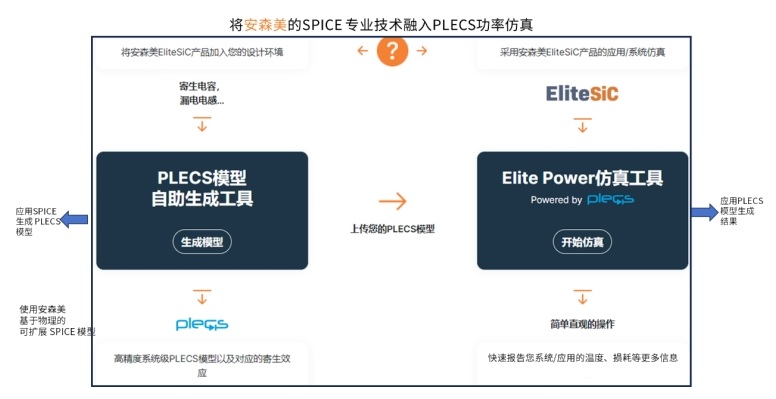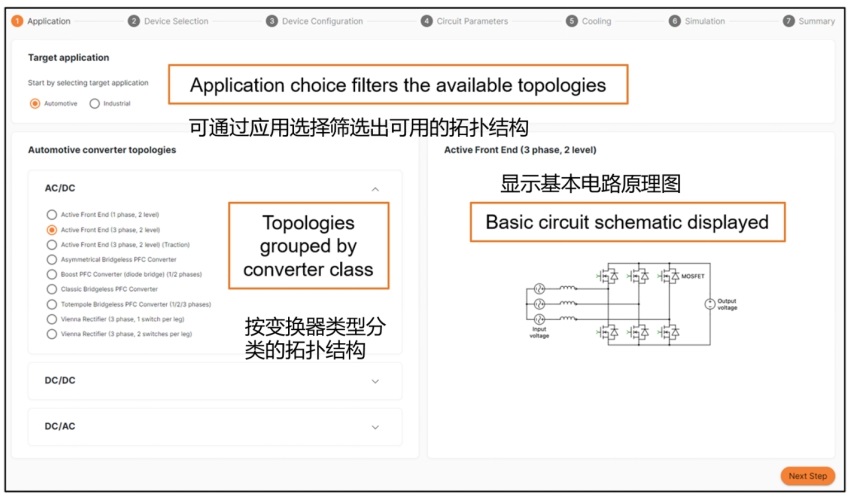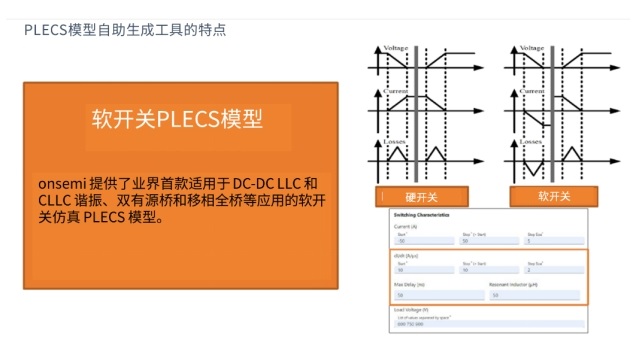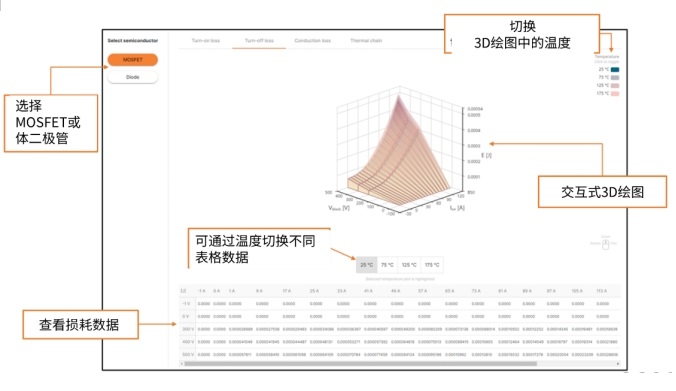Evolving power electronics design: ON Advanced Simulation tools
Time:2024-04-15
Views:223
Source: ON Semiconductor Author: James Victory
Power electronics design is a critical element in modern engineering and has a profound impact on the efficiency, reliability and performance of many applications. Developing circuits that meet stringent requirements while considering manufacturing process differences and worst-case scenarios requires precise and sophisticated tool support.
The field of power electronics design is evolving rapidly, ushering in a new era of high-speed, efficient components. In this evolution, onsemi has introduced breakthrough simulation tools that are redefining the way engineers conceptualize, design and validate power systems. On‘s new Elite Power simulation tool and PLECS Model Self-Build Tool (SSPMG) enable power electronics engineers to reduce time to market. When applied to the EliteSiC family of products, these tools can accurately show the actual operating behavior of the circuit, especially when the EliteSiC technology is operated under boundary conditions.

Figure 1: Elite Power Simulation tool and PLECS model self-generation tool
At the forefront of this innovation is an intuitive and comprehensive simulation platform that enables engineers to visualize, simulate, and optimize complex power electronics topologies with unprecedented ease. This tool provides engineers with a unique digital environment to test and refine designs, thus advancing the state of the art. PLECS models and their accuracy are critical to the effectiveness of Elite Power simulation tools. The simulation tool enables engineers to upload custom PLECS models generated by SSPMG.
The core of this simulation tool is its ability to accurately simulate a variety of power electronics topologies, including AC-DC, DC-DC, and DC-AC converters. The more than 40 topological options offered by On Beauty make it a leader in the industry, giving engineers a rich resource base to explore and optimize their designs. In industrial applications, ON‘s Elite Power simulation tools show great value in supporting critical systems such as DC fast charge, uninterruptible power supplies (UPS), energy storage systems (ESS) and solar inverters. Similarly, this tool is also suitable for on-board charger (OBC) and main drive inverter systems in the automotive industry.
Figure 2: Select the application and topology in the Elite emulation tool
Challenge
In the past, the industry mainly created PLECS models using measurement-based loss tables with reference to the manufacturer‘s data manual. However, this approach faces several major challenges:
1, dependent on measurement Settings: Switching loss data is affected by specific application layout and circuit parasitic parameters, resulting in data variations and inaccuracies.
2, limited data density: The on-off and switching loss data are usually not dense enough, which prevents accurate interpolation calculations in PLECS and often requires extrapolation calculations, which may affect accuracy.
3. Typical semiconductor conditions: Loss data usually represent nominal semiconductor process conditions, which may ignore various changes and real scenarios in practical applications.
4, only applicable to the hard switch case: The model established by the double pulse loss data generated from the data manual is only applicable to the hard switch topology. When applied to soft-switching topologies or synchronous rectification simulations, the accuracy of these models can be greatly reduced.
By introducing the PLECS Model Self-Generation Tool (SSPMG), ON Semiconductor has solved the problem faced by the traditional method of generating PLECS models based on measurement loss tables. The tool optimizes the model taking into account the impact of specific passive components on energy loss, providing denser and more detailed data for accurate simulations. SSPMG incorporates changes in the semiconductor process to build real-world models and create adaptable models for soft switching topologies to ensure reliability beyond hard switching scenarios. This level of customization ensures that the simulations performed truly reflect the actual working conditions of the user, eliminating the inaccuracies associated with models based on the generic data manual. PLECS models designed with SSPMG can be seamlessly uploaded to the Elite Power simulation tool or downloaded into a standalone PLECS.
Figure 3: One of the characteristics of SSPMG - intensive loss table

Figure 4: Soft switch simulation, one of the features of SSPMG
Simulation tool
The core advantage of the tool is its system-level simulation tool PLECS, which runs in the background. PLECS is a system-level simulation tool that uses component models designed for speed and accuracy to simplify the modeling and simulation of entire systems. The tool combines an easy-to-use web-based environment to give engineers an edge in the design process.
The significance of this tool goes beyond its simulation capabilities. More than just a simulation tool, it is a powerful guide to help engineers select the ideal components for their applications. The tool supports On‘s extensive product line, allowing engineers to seamlessly navigate a wide range of product families, weigh performance against cost, and make informed decisions.
PLECS is not a Spice-based circuit simulation tool and does not focus on the low-level behavior of circuit components. Power transistors are viewed as simple switches that can be easily configured to demonstrate the loss associated with on-off and on-off transitions. The PLECS model, known as the "thermal model," includes lookup tables for on-off losses and on-off losses, as well as a thermal chain structure in the form of a Cauer or Foster equivalent network.
Key features of Elite Power Simulation tools
As mentioned earlier, the ability to generate and upload custom PLECS models with SSPMG enables users to accurately simulate their application environment. This ability is ahead of its time in the industry.
The simulation tool has intuitive loss and thermal data mapping capabilities, allowing engineers to visualize the loss performance of selected switches. This versatile 3D visualization tool combines data such as device on-loss, switching loss, and thermal impedance.
This simulation tool provides the ability to design a custom heat sink model, enabling users to accurately predict node temperatures and optimize cooling solutions for their specific needs.
The simulation phase in this tool provides very detailed details of various parameters such as loss, efficiency and node temperature under both transient and steady-state conditions. In addition, the tool has a shortcut mechanism to compare the operation of different devices, circuit parameters, cooling designs and loss models.
Figure 5: Loss mapping is one of the features of the Elite Power simulation tool
A big advantage of this tool is its ability to provide data for further analysis. Users can download comprehensive data sets, including transient waveform range data, in CSV format for in-depth analysis in their own environment. The simulation tool also includes a downloadable PLECS model. These capabilities enable engineers to conduct in-depth evaluations and fine-tune designs for optimal performance.
This simulation tool and SSPMG can be adapted to a wide range of semiconductor technologies. Although initially focused on silicon carbide products, the two tools will gradually expand to other power devices. This wide range of applications ensures that engineers can leverage these tools for a wide range of devices and tailor simulation solutions to their specific needs.
precision
The application of simulation tools in virtual prototyping has brought great changes to the design process. Today, engineers and designers can understand the performance of these electronic circuits before mass production, so that the ideal performance can be achieved for the first time. Accuracy is a crucial factor when simulating complex electronic circuits. Simulations beyond the conditions of the data book are particularly critical, as large amounts of data are available that would normally be difficult to obtain through physical testing. This simulation method helps to optimize and analyze circuit performance in a virtual environment. By applying accurate simulation techniques, it is possible to avoid underestimating or overestimating system performance. However, in this process, the accuracy of the model plays a decisive role. The classic rule that "bad input leads to bad output" also applies to this scenario. On shares this philosophy and goes to great lengths to ensure that accurate models are available at both SPICE and PLECS levels.
24/7 global team of professionals and a vast library of documentation such as user guides and application notes, we ensure that users have the necessary resources to succeed. Our continued participation in industry conferences, webinars and educational training events further underscores our strong commitment to empowering and educating our users. Videos and webinars are useful resources to guide users through the complex features of our simulation tools, not only explaining the steps, but also teaching users the meaning behind each action to ensure a thorough and in-depth understanding.
About the author
James Victory is currently a Senior Research Fellow at ON, focusing on modeling and simulation research and development in the field of power technology. In June 2008, he founded Sentinel IC Technologies, a company specializing in the design and implementation of RF simulation and power technologies. Prior to that, he served as Executive Director of Design at Jazz Semiconductor. He began his career in 1992 at MOTOROLA, where he focused on modeling semiconductor devices for RF simulation and power technology. He received a bachelor‘s degree in electrical engineering from Arizona State University in 1990, a master‘s degree in 1992 and a doctorate in 1994. To date, he has published more than 50 academic publications, including invited papers and lecture courses, and holds six patents on semiconductor device modeling and simulation.
Power electronics design is a critical element in modern engineering and has a profound impact on the efficiency, reliability and performance of many applications. Developing circuits that meet stringent requirements while considering manufacturing process differences and worst-case scenarios requires precise and sophisticated tool support.
The field of power electronics design is evolving rapidly, ushering in a new era of high-speed, efficient components. In this evolution, onsemi has introduced breakthrough simulation tools that are redefining the way engineers conceptualize, design and validate power systems. On‘s new Elite Power simulation tool and PLECS Model Self-Build Tool (SSPMG) enable power electronics engineers to reduce time to market. When applied to the EliteSiC family of products, these tools can accurately show the actual operating behavior of the circuit, especially when the EliteSiC technology is operated under boundary conditions.

Figure 1: Elite Power Simulation tool and PLECS model self-generation tool
The core of this simulation tool is its ability to accurately simulate a variety of power electronics topologies, including AC-DC, DC-DC, and DC-AC converters. The more than 40 topological options offered by On Beauty make it a leader in the industry, giving engineers a rich resource base to explore and optimize their designs. In industrial applications, ON‘s Elite Power simulation tools show great value in supporting critical systems such as DC fast charge, uninterruptible power supplies (UPS), energy storage systems (ESS) and solar inverters. Similarly, this tool is also suitable for on-board charger (OBC) and main drive inverter systems in the automotive industry.

Figure 2: Select the application and topology in the Elite emulation tool
In the past, the industry mainly created PLECS models using measurement-based loss tables with reference to the manufacturer‘s data manual. However, this approach faces several major challenges:
1, dependent on measurement Settings: Switching loss data is affected by specific application layout and circuit parasitic parameters, resulting in data variations and inaccuracies.
2, limited data density: The on-off and switching loss data are usually not dense enough, which prevents accurate interpolation calculations in PLECS and often requires extrapolation calculations, which may affect accuracy.
3. Typical semiconductor conditions: Loss data usually represent nominal semiconductor process conditions, which may ignore various changes and real scenarios in practical applications.
4, only applicable to the hard switch case: The model established by the double pulse loss data generated from the data manual is only applicable to the hard switch topology. When applied to soft-switching topologies or synchronous rectification simulations, the accuracy of these models can be greatly reduced.
By introducing the PLECS Model Self-Generation Tool (SSPMG), ON Semiconductor has solved the problem faced by the traditional method of generating PLECS models based on measurement loss tables. The tool optimizes the model taking into account the impact of specific passive components on energy loss, providing denser and more detailed data for accurate simulations. SSPMG incorporates changes in the semiconductor process to build real-world models and create adaptable models for soft switching topologies to ensure reliability beyond hard switching scenarios. This level of customization ensures that the simulations performed truly reflect the actual working conditions of the user, eliminating the inaccuracies associated with models based on the generic data manual. PLECS models designed with SSPMG can be seamlessly uploaded to the Elite Power simulation tool or downloaded into a standalone PLECS.

Figure 3: One of the characteristics of SSPMG - intensive loss table

Figure 4: Soft switch simulation, one of the features of SSPMG
The core advantage of the tool is its system-level simulation tool PLECS, which runs in the background. PLECS is a system-level simulation tool that uses component models designed for speed and accuracy to simplify the modeling and simulation of entire systems. The tool combines an easy-to-use web-based environment to give engineers an edge in the design process.
The significance of this tool goes beyond its simulation capabilities. More than just a simulation tool, it is a powerful guide to help engineers select the ideal components for their applications. The tool supports On‘s extensive product line, allowing engineers to seamlessly navigate a wide range of product families, weigh performance against cost, and make informed decisions.
PLECS is not a Spice-based circuit simulation tool and does not focus on the low-level behavior of circuit components. Power transistors are viewed as simple switches that can be easily configured to demonstrate the loss associated with on-off and on-off transitions. The PLECS model, known as the "thermal model," includes lookup tables for on-off losses and on-off losses, as well as a thermal chain structure in the form of a Cauer or Foster equivalent network.
Key features of Elite Power Simulation tools
As mentioned earlier, the ability to generate and upload custom PLECS models with SSPMG enables users to accurately simulate their application environment. This ability is ahead of its time in the industry.
The simulation tool has intuitive loss and thermal data mapping capabilities, allowing engineers to visualize the loss performance of selected switches. This versatile 3D visualization tool combines data such as device on-loss, switching loss, and thermal impedance.
This simulation tool provides the ability to design a custom heat sink model, enabling users to accurately predict node temperatures and optimize cooling solutions for their specific needs.
The simulation phase in this tool provides very detailed details of various parameters such as loss, efficiency and node temperature under both transient and steady-state conditions. In addition, the tool has a shortcut mechanism to compare the operation of different devices, circuit parameters, cooling designs and loss models.

Figure 5: Loss mapping is one of the features of the Elite Power simulation tool
This simulation tool and SSPMG can be adapted to a wide range of semiconductor technologies. Although initially focused on silicon carbide products, the two tools will gradually expand to other power devices. This wide range of applications ensures that engineers can leverage these tools for a wide range of devices and tailor simulation solutions to their specific needs.
precision
The application of simulation tools in virtual prototyping has brought great changes to the design process. Today, engineers and designers can understand the performance of these electronic circuits before mass production, so that the ideal performance can be achieved for the first time. Accuracy is a crucial factor when simulating complex electronic circuits. Simulations beyond the conditions of the data book are particularly critical, as large amounts of data are available that would normally be difficult to obtain through physical testing. This simulation method helps to optimize and analyze circuit performance in a virtual environment. By applying accurate simulation techniques, it is possible to avoid underestimating or overestimating system performance. However, in this process, the accuracy of the model plays a decisive role. The classic rule that "bad input leads to bad output" also applies to this scenario. On shares this philosophy and goes to great lengths to ensure that accurate models are available at both SPICE and PLECS levels.
24/7 global team of professionals and a vast library of documentation such as user guides and application notes, we ensure that users have the necessary resources to succeed. Our continued participation in industry conferences, webinars and educational training events further underscores our strong commitment to empowering and educating our users. Videos and webinars are useful resources to guide users through the complex features of our simulation tools, not only explaining the steps, but also teaching users the meaning behind each action to ensure a thorough and in-depth understanding.
About the author
James Victory is currently a Senior Research Fellow at ON, focusing on modeling and simulation research and development in the field of power technology. In June 2008, he founded Sentinel IC Technologies, a company specializing in the design and implementation of RF simulation and power technologies. Prior to that, he served as Executive Director of Design at Jazz Semiconductor. He began his career in 1992 at MOTOROLA, where he focused on modeling semiconductor devices for RF simulation and power technology. He received a bachelor‘s degree in electrical engineering from Arizona State University in 1990, a master‘s degree in 1992 and a doctorate in 1994. To date, he has published more than 50 academic publications, including invited papers and lecture courses, and holds six patents on semiconductor device modeling and simulation.
|
Disclaimer: This article is transferred from other platforms and does not represent the views and positions of this site. If there is any infringement or objection, please contact us to delete it. thank you! |











